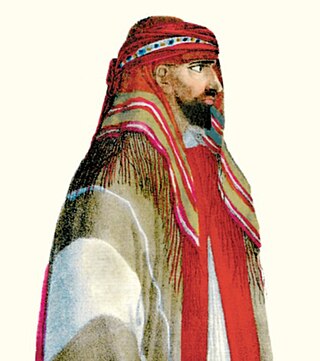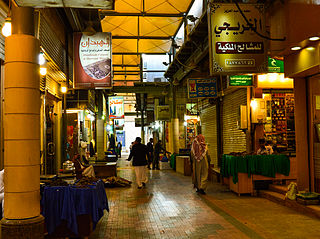
The history of Saudi Arabia as a nation state began with the emergence of the Al Saud dynasty in central Arabia in 1727 and the subsequent establishment of the Emirate of Diriyah. Pre-Islamic Arabia, the territory that constitutes modern Saudi Arabia, was the site of several ancient cultures and civilizations; the prehistory of Saudi Arabia shows some of the earliest traces of human activity in the world.

Najd is the central region of Saudi Arabia, in which about a third of the country's modern population resides. It is the home of the House of Saud, from which it pursued unification with Hejaz since the time of the Emirate of Diriyah.
Abdulaziz bin Muhammad Al Saud was the second ruler of the Emirate of Diriyah. He was the eldest son of Muhammad bin Saud and the son-in-law of Muhammad bin Abdul Wahhab. Abdulaziz ruled the Emirate from 1765 until 1803. He was nicknamed by his people as the savior of his time due to his fearless activities.
Saud bin Abdulaziz Al Saud ruled the First Saudi State from 1803 to 1814. Saud annexed Mecca and Medina from the Ottoman Empire making him the first Al Saud ruler who received the title of the servant of the Two Holy Cities. During his rule the state experienced a significant level of strength and expansion for which he was called Saud Al Kabeer or Saud the Great.

Abdullah bin Saud Al Saud was the ruler of the First Saudi State from 1814 to 1818. He was the last ruler of the First Saudi State and was executed in Constantinople under the Ottoman Empire. Although the Ottomans maintained several garrisons in the Nejd thereafter, they were unable to prevent the rise of the Emirate of Nejd, also known as the Second Saudi State, led by Turki bin Abdullah.
The Wahhabi war, also known as the Ottoman-Saudi War, (1811–1818) was fought from early 1811 to 1818, between the Ottoman Empire and the Emirate of Diriyah, the First Saudi State, resulting in the destruction of the latter.
Faisal bin Turki Al Saud was the second ruler of the Second Saudi State and seventh head of the House of Saud.

The Emirate of Nejd or Imamate of Nejd was the Second Saudi State, existing between 1824 and 1891 in Nejd, the regions of Riyadh and Ha'il of what is now Saudi Arabia. Saudi rule was restored to central and eastern Arabia after the Emirate of Diriyah, the First Saudi State, having previously been brought down by the Ottoman Empire's Egypt Eyalet in the Ottoman–Wahhabi War (1811–1818).
Turki bin Abdullah Al Saud was the founder of the Second Saudi State and ruled Najd from 1823–1834 following administration by the Ottoman Empire.
Saud bin Faisal Al Saud, also known as Imam Saud, (1833—1875) was the ruler of the Second Saudi State in 1871 and 1873–75. He joined alliances with foreign tribes and revolted against his half-brother Abdullah. His rule was short-lived and Abdullah overthrew him. Saud gained power again in 1873 but died two years later. His reign was notable for the infighting in the House of Saud which he initiated.

The Unification of Saudi Arabia was a military and political campaign in which the various tribes, sheikhdoms, city-states, emirates, and kingdoms of most of the central Arabian Peninsula were conquered by the House of Saud, or Al Saud. Unification started in 1902 and continued until 1932, when the Kingdom of Saudi Arabia was proclaimed under the leadership of Abdulaziz, known in the West as Ibn Saud, creating what is sometimes referred to as the Third Saudi State, to differentiate it from the Emirate of Diriyah, the First Saudi State and the Emirate of Nejd, the Second Saudi State, also House of Saud states.
The Ghamd is an Azd Arab tribe of the Hejaz Region. They are predominantly Sunni, and are considered one of the oldest tribes of the Arabian Peninsula. The Ghamid people are thought to be closely related to the neighboring tribe of Zahran.
Al-Khaldi, also spelled Al Khalidi is the last name given to descendants of the Bani Khalid. The tribe traditionally claims descent from Khalid ibn al-Walid a senior companion of the Islamic prophet Muhammad, and esteemed general who was crucial in the Islamic Conquest of Persia and Syria. This claim has been questioned by Arab genealogists who have suggested that the tribe may descend from his relatives from Banu Makhzum and not from Khalid himself, alternatively, they have largely been attributed to. The tribe has historically been powerful in the Arabian Peninsula, having ruled Southern Iraq, Kuwait, and Eastern Arabia after expelling Ottoman and Portuguese forces in 1670. After their conflict and fall to the Emirate of Diriyah, many Khalidis scattered to Iraq and the Levant, where many of them remain to this day. The Khalidis were reinstated in power by the Ottomans after the deposition of the first Saudi State in the early 19th century, but the Saudis would quickly rise again and permanently remove them from power. Today the overwhelming majority of the descendants of the tribe live in Saudi Arabia as well as Kuwait, Qatar, Oman, Lebanon, Iraq, Jordan, and Palestine.

The Ottoman era in the history of Arabia lasted from 1517 to 1918. The Ottoman degree of control over these lands varied over these four centuries, with the fluctuating strength or weakness of the Empire's central authority.
Abdullah bin Ali Al Rashid (1788–1848) was the founder of the Emirate of Jabal Shammar. He founded the Emirate in 1836 and ruled it until 1848. He was called Sheikh due to his noble lineage and military ability.
Abdullah bin Faisal Al Saud was one of the rulers of the Emirate of Najd, also known as Second Saudi State. His reign witnessed extensive struggle among the members of the Al Saud family which led to turmoil in the region.

The Al-Hasa Expedition was an Ottoman military campaign to annex the El-Hasa region of eastern Arabia. Ostensibly launched to assist Imam Abdullah bin Faisal in reclaiming control over Najd from his brother Saud bin Faisal, the underlying motive was Medhat Pasha's ambition to extend Ottoman dominion over the Persian Gulf.
Khalid bin Saud bin Abdulaziz Al Saud (1811–1865) ruled the Second Saudi State, Emirate of Najd, for three years, between 1838 and 1841. His reign was part of Muhammad Ali Pasha's, ruler of Egypt, plans to dominate Arabia following his capture of Syria in 1831. Khalid was the great-grandson of Muhammad bin Saud, founder of the Al Saud dynasty, and second cousin of Faisal bin Turki bin Abdullah, another ruler of the Second Saudi State.

Old Riyadh is an umbrella term used for a loosely defined region that primarily lies in the southern portion of modern-day Riyadh, Saudi Arabia, encompassing neighborhoods and settlements that emerged from ruins of Hajr al-Yamamah in late 16th century, the erstwhile walled town enclosed within the defensive fortifications and its immediate vicinity prior to its demolition in 1950, and villages and former towns located along the outskirts of Riyadh that got incorporated into the metropolis following multiple phases of expansion and modernization between the 1950s and 1970s. To some extent, neighborhoods excluded during Riyadh's rapid urbanization during the same period are also categorized as part of old districts, with most of them situated in the modern downtown.

Saudi Founding Day, officially the Founding Day, is a public holiday in Saudi Arabia celebrated annually on February 22 to commemorate the enthronement of Muhammad bin Saud as the emir of the oasis town of Diriyah in 1727 following the death of his father Saud al-Muqrin, the eponymous ancestor of the al-Saud family. His hereditary succession is considered as the prelude to the inception of the First Saudi State, the antecedent to the Second Saudi State and present-day Kingdom of Saudi Arabia. It was founded in 2022 on its 295th anniversary when King Salman bin Abdulaziz issued a royal decree that designated it as a legal holiday to be observed as per the Gregorian calendar. It is one of the three non-religious national holidays observed in the country, other being the Saudi National Day and Saudi Flag Day.









